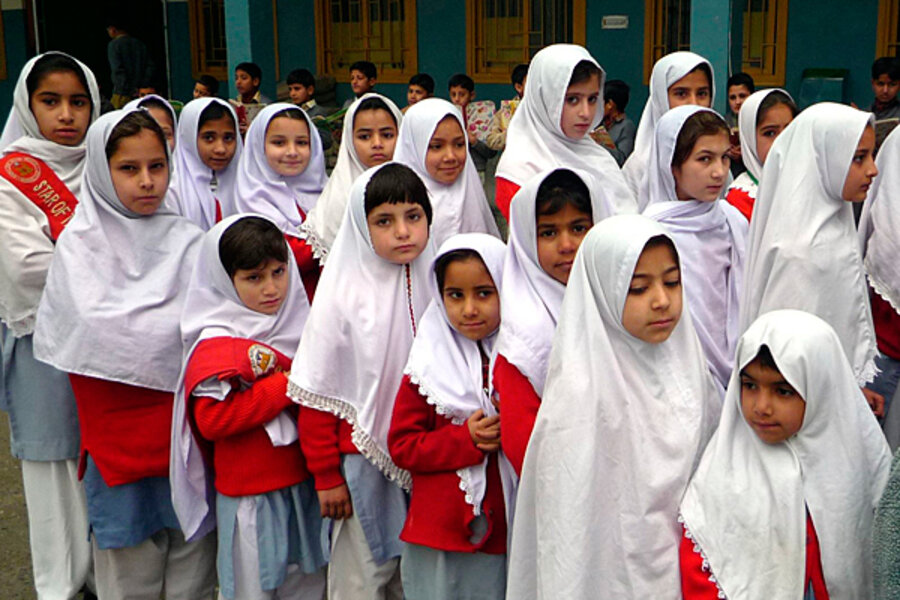How the Taliban sent more girls to school in Pakistan
Loading...
| Mingora, Pakistan
On weekday mornings in Mingora, the largest city in Swat Valley, Pakistan, the streets are filled with boys heading to school. Among them are smaller groups of schoolgirls laughing and tucking books under their arms, as they, too, head to school.
The scene highlights how far the region has come in the past few years: The Swat Valley, famed for its picturesque mountains, saw more than 400 schools destroyed – more than half of them girls' schools – when the Taliban took control of the region in 2008.
The valley was cleared of the Taliban by a military operation in 2009, but it's taken a while for girls to fill the schools again. Girls struggle to simply get to school in the remote mountainous region and the persistent issue of poverty remains key. The Taliban is considered a greater threat in areas that border the valley, but activists here say there's a need to make sure girls as well as boys are educated in order to avoid a repeat of the past.
“There is a feeling [in Swat] that if we are not educated these things will happen again," says Hazer Gul, a local activist. "The Mullahs misinformed us. They [the community] have understood that education is the key to avoiding militants.”
Enter the Malala Fund: The fund named for Malala Yousafzai, the young girl who was shot point blank by a Taliban gunman for her vocal support of school for girls in the region, aims to improve access to primary school education for children around the world. Her survival of the Taliban attack on her schoolbus one year ago October, shined a spotlight on Pakistani girls education - and made her a global spokesman for the millions of Pakistani girls the movement would like to deny education.
The fund’s first program is now attempting to unravel the Taliban's legacy in her home valley.
As part of an initial program, the Malala Fund teamed up with Vital Voices, a Washington-based organization, to financially support 40 girls between the ages of 5 and 12 from Malala’s hometown who would otherwise be working to support their families so that they could go to school.
After the Malala incident, the Swat Valley came to represent the hurdles facing girls throughout Pakistan, where only about 40 percent of school-aged girls are enrolled in school, according to the United Nations.
Today the number of girls' schools in Swat is a fraction of the number of schools available to boys: 717 primary schools for boys compared with 425 for girls, according to official figures. The gap is even more pronounced at the middle and high school level, according to the Elementary and Secondary Education Department of Khyber Paktunkhwa Province.
For many living in the Swat Valley, the key obstacle to education for girls is poverty.
“The girls are coming to school, but they often skip school. During harvest, the mothers earn 400 – 500 rupees ($3.75 – $4.70) per day [working in the fields] so the girls have to stay at the home to look after the home and the younger children,” explains Shaheena Shaukat, the principal of a primary school for girls in Gul Bandai, a small village in Swat.
Indeed, it wasn’t until the Malala Fund offered the families of the girls a monthly stipend of 15,000 rupees ($142) that the families agreed to take the girls out of work and send them to school, explains Ahmad Shah, a volunteer with the Malala Fund and close friend of Malala’s father. That was key to helping the girls get to school.
Girls like Ayesha.
Five months ago Ayesha Khurshid was able to swap her broom for books as one of 40 girls to receive a scholarship from the Malala Fund.
For as long as she can remember, 7-year-old Ayesha has accompanied her mother each day to the school where her mother works sweeping the school grounds and fetching cups of tea for staff. Once Ayesha was big enough to hold a broom, she helped her mother at the school, earning a few extra rupees for the family. But she says she always wanted to sit at the desks with the other students.
Ayesha’s dream today is to be able to stay in school until she’s grown up, she says. The drop out rate for girls after class 5 (9-10 year olds) remains very high. Most girls have to travel beyond their village to go to middle and high school. Combined with the increasing restrictions girls face in the conservative Islamic society as they grow up, many parents stop sending their daughters to school.
Still, some worry such programs are only addressing one part of the problem.
“[The government has] rebuilt the schools that were destroyed, but [those schools] were deficient,” says Talimand Khan, an education researcher with the Sustainable Development Policy Institute, an Islamabad-based think tank, and a Swat native. Mr. Khan says that there needs to be a focus on improving the quality of the education – not just on the bricks and mortar.
“We’ve got back to square one,” he says, “But that is not an improvement.”







